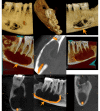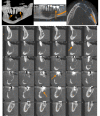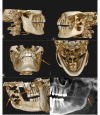An Insight Into the Effect of Odontogenic Keratocysts on Surrounding Structures: Cone-Beam Computed Tomography-Based Analysis of Cases
- PMID: 37461795
- PMCID: PMC10349913
- DOI: 10.7759/cureus.40488
An Insight Into the Effect of Odontogenic Keratocysts on Surrounding Structures: Cone-Beam Computed Tomography-Based Analysis of Cases
Abstract
Introduction An odontogenic keratocyst (OKC) is a benign intraosseous lesion with potential to demonstrate aggressive and invasive behavior. The aim of this retrospective study was to analyze the imaging features of the OKC using cone-beam computed tomography (CBCT) and to evaluate the association between the internal structure of the lesion and the effect of the lesion on surrounding structures. Methods Overall, 32 CBCT scans of histopathologically diagnosed cases of OKC were analyzed retrospectively. The following variables were analyzed: anatomic location of the lesions (mandible body (right/left), ramus (right/left), mandible body+ramus (right/left), maxilla (right/left), and both jaws), the internal structure of the lesion (unilocular/multilocular), and the effect of the lesion on the surrounding anatomical structures (involvement of the inferior alveolar nerve canal (IANC), displacement of the IANC, cortical expansion, displacement of the tooth, resorption of the root, associated impacted tooth, associated missing tooth). We also looked for the association between the internal structure and the effect of the lesion on anatomic structures. Results Out of 32 cases, 29 (90.6%) cases involved the mandible alone. Statistically significant association (p-value 0.005) was present between the internal structure and mean age of presentation as well as between the internal structure and impacted tooth (p-value 0.027). The association between the internal structure and other variables was statistically not significant. Conclusions The radiographic features of OKCs can be variable, and these lesions have a considerable effect on the tooth, IANC, and cortical bone. Significant association was found between the internal structure, age, and impacted tooth. Since OKCs have a high recurrence rate, CBCT is advised for evaluating the extent and location of any cortical perforations.
Keywords: cone-beam computed tomography; mandible; maxilla; multilocular; odontogenic keratocyst; unilocular.
Copyright © 2023, AC et al.
Conflict of interest statement
The authors have declared that no competing interests exist.
Figures





References
-
- Shafer Shafer, Hine Hine, Levy Levy. India: Elsevier; 2012. Shafer’s Textbook of Oral Pathology-Seventh Edition.
-
- White SC, Pharoah MJ. India: Elsevier; 2019. White and Pharoah's Oral Radiology: Principles and Interpretation-Second South Asia Edition.
-
- A review of odontogenic keratocysts and the behavior of recurrences. Chirapathomsakul D, Sastravaha P, Jansisyanont P. Oral Surg Oral Med Oral Pathol Oral Radiol Endodontology. 2006 ;101:5–9. - PubMed
-
- Frequency of odontogenic cysts and tumors: a systematic review. Johnson NR, Gannon OM, Savage NW, Batstone MD. J Investig Clin Dent . 2014;5:9–14. - PubMed
LinkOut - more resources
Full Text Sources
